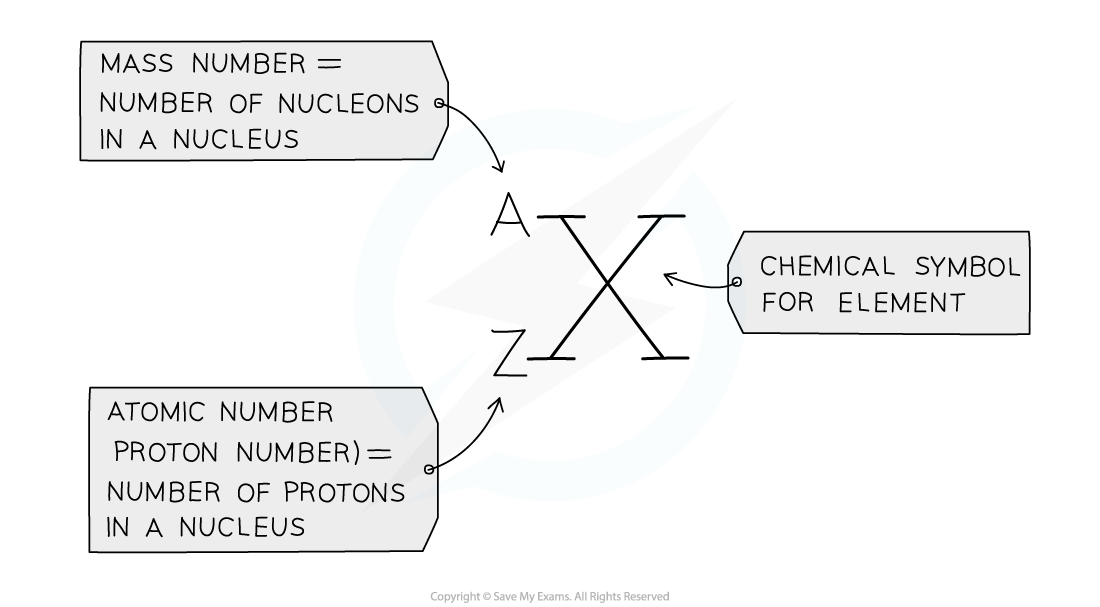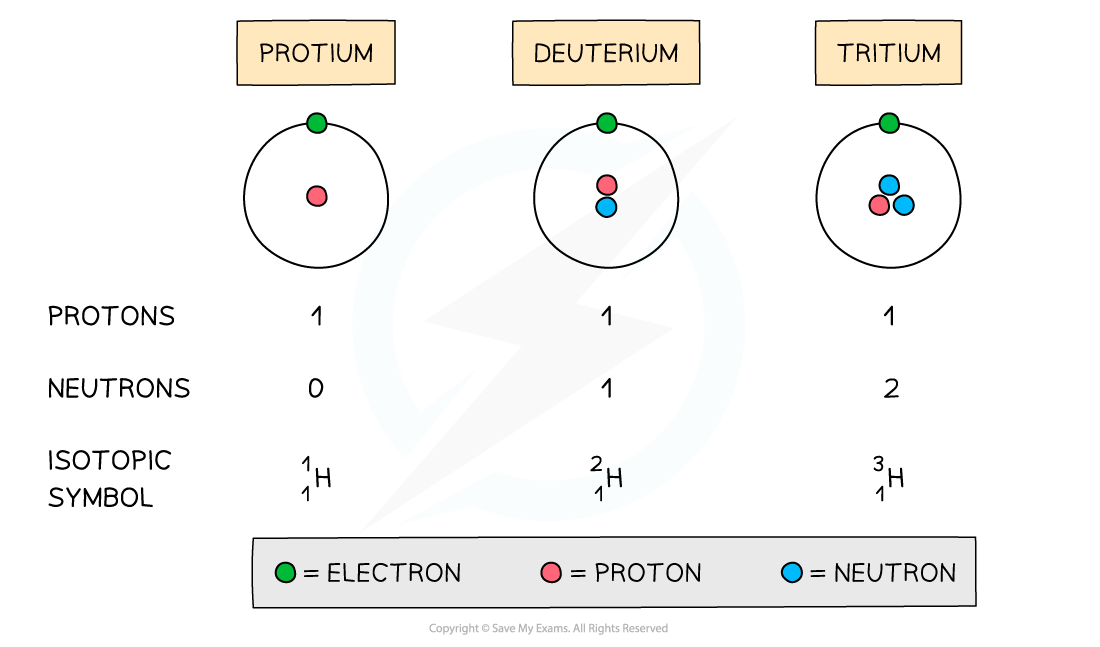Atoms: Key Terms
- The atomic number (or proton number) is the number of protons in the nucleus of an atom and has the symbol Z
- The atomic number is also equal to the number of electrons that are present in a neutral atom of an element
- E.g. the atomic number of lithium is 3, meaning that a neutral lithium atom has 3 protons and, therefore, also has 3 electrons
- The mass number (or nucleon number) is the total number of protons + neutrons in the nucleus of an atom, and has the symbol A
- The number of neutrons can be calculated by:
Number of neutrons = mass number - atomic number
- Protons and neutrons are also called nucleons, because they are found in the nucleus
Exam Tip

The mass (nucleon) and atomic (proton) number are given for each element in the Periodic Table
Isotopes: Basics
- Isotopes are atoms of the same element that contain the same number of protons and electrons but a different number of neutrons
- The way to represent an isotope is to write the chemical symbol (or the word) followed by a dash and then the mass number
- E.g. carbon-12 and carbon-14 are isotopes of carbon containing 6 and 8 neutrons respectively
- These isotopes could also be written as 12C or C-12, and 14C or C-14 respectively

The atomic structure and symbols of the three isotopes of hydrogen
Determining the Subatomic Structure of Atoms & Ions
- An atom is neutral and has no overall charge
- Ions on the other hand have either gained or lost electrons causing them to become charged
- The number of subatomic particles in atoms and ions can be determined given their atomic (proton) number, mass (nucleon) number and charge
Protons
- The atomic number of an atom and ion determines which element it is
- Therefore, all atoms and ions of the same element have the same number of protons (atomic number) in the nucleus
- E.g. lithium has an atomic number of 3 (three protons) whereas beryllium has atomic number of 4 (4 protons)
- The number of protons equals the atomic (proton) number
- The number of protons of an unknown element can be calculated by using its mass number and number of neutrons:
Mass number = number of protons + number of neutrons
Number of protons = mass number - number of neutrons
Worked Example
Determine the number of protons of the following ions and atoms:
- Mg2+ ion
- Carbon atom
- An unknown atom of element X with mass number 63 and 34 neutrons
Answer:
Answer 1: The atomic number of a magnesium atom is 12 suggesting that the number of protons in the magnesium element is 12
- Therefore the number of protons in a Mg2+ ion is also 12 - the number of protons does not change when an ion is formed
Answer 2: The atomic number of a carbon atom is 6 suggesting that a carbon atom has 6 protons in its nucleus
Answer 3: Use the formula to calculate the number of protons
Number of protons = mass number - number of neutrons
Number of protons = 63 - 34
Number of protons = 29
- Element X is therefore copper
Electrons
- An atom is neutral and therefore has the same number of protons and electrons
- Ions have a different number of electrons to the number of protons, depending on their charge
- A positively charged ion has lost electrons and therefore has fewer electrons than protons
- A negatively charged ion has gained electrons and therefore has more electrons than protons
Worked Example
Determine the number of electrons of the following ions and atoms:
- Mg2+ ion
- Carbon atom
- An unknown atom of element X with mass number 63 and 34 neutrons
Answer:
Answer 1: The atomic number of a magnesium atom is 12 suggesting that the number of protons in the neutral magnesium atom is 12
- However, the 2+ charge in Mg2+ ion suggests it has lost two electrons
- It only has 10 electrons left now
Answer 2: The atomic number of a carbon atom is 6 suggesting that the neutral carbon atom has 6 electrons orbiting around the nucleus
Answer 3: The number of protons of element X can be calculated by:
Number of protons = mass number - number of neutrons
Number of protons = 63 - 34
Number of protons = 29
- The neutral atom of element X therefore also has 29 electrons
Neutrons
- The mass and atomic numbers can be used to find the number of neutrons in ions and atoms:
Number of neutrons = mass number (A) - number of protons (Z)
Worked Example
Determine the number of neutrons of the following ions and atoms:
- Mg2+ ion
- Carbon atom
- An unknown atom of element X with mass number 63 and 29 protons
Answer:
Answer 1: The atomic number of a magnesium atom is 12 and its mass number is 24
Number of neutrons = mass number (A) - number of protons (Z)
Number of neutrons = 24 - 12
Number of neutrons = 12
- The Mg2+ ion has 12 neutrons in its nucleus
Answer 2: The atomic number of a carbon atom is 6 and its mass number is 12
Number of neutrons = mass number (A) - number of protons (Z)
Number of neutrons = 12 - 6
Number of neutrons = 6
- The carbon atom has 6 neutrons in its nucleus
Answer 3: The atomic number of an element X atom is 29 and its mass number is 63
Number of neutrons = mass number (A) - number of protons (Z)
Number of neutrons = 63 - 29
Number of neutrons = 34
- The neutral atom of element X has 34 neutrons in its nucleus
